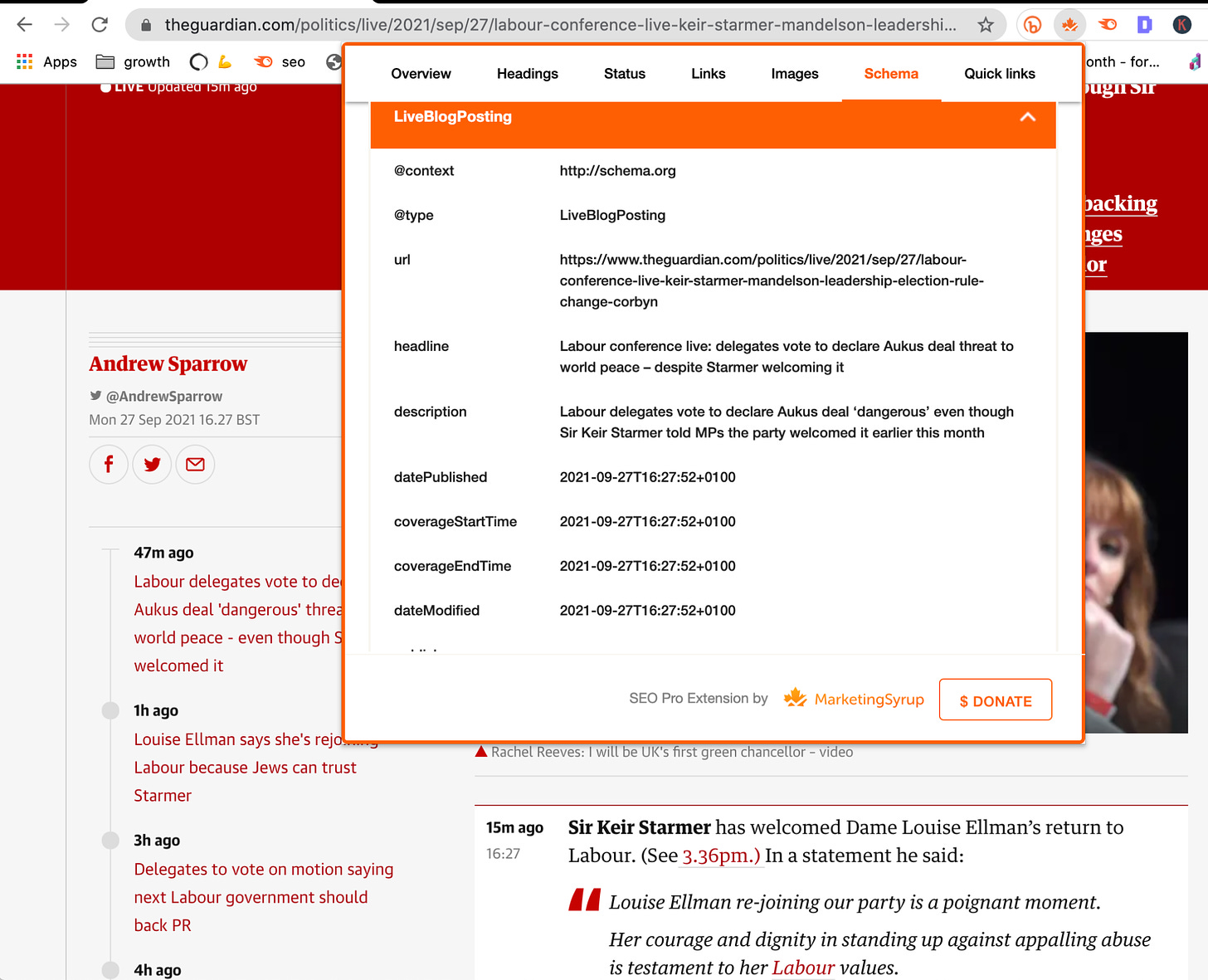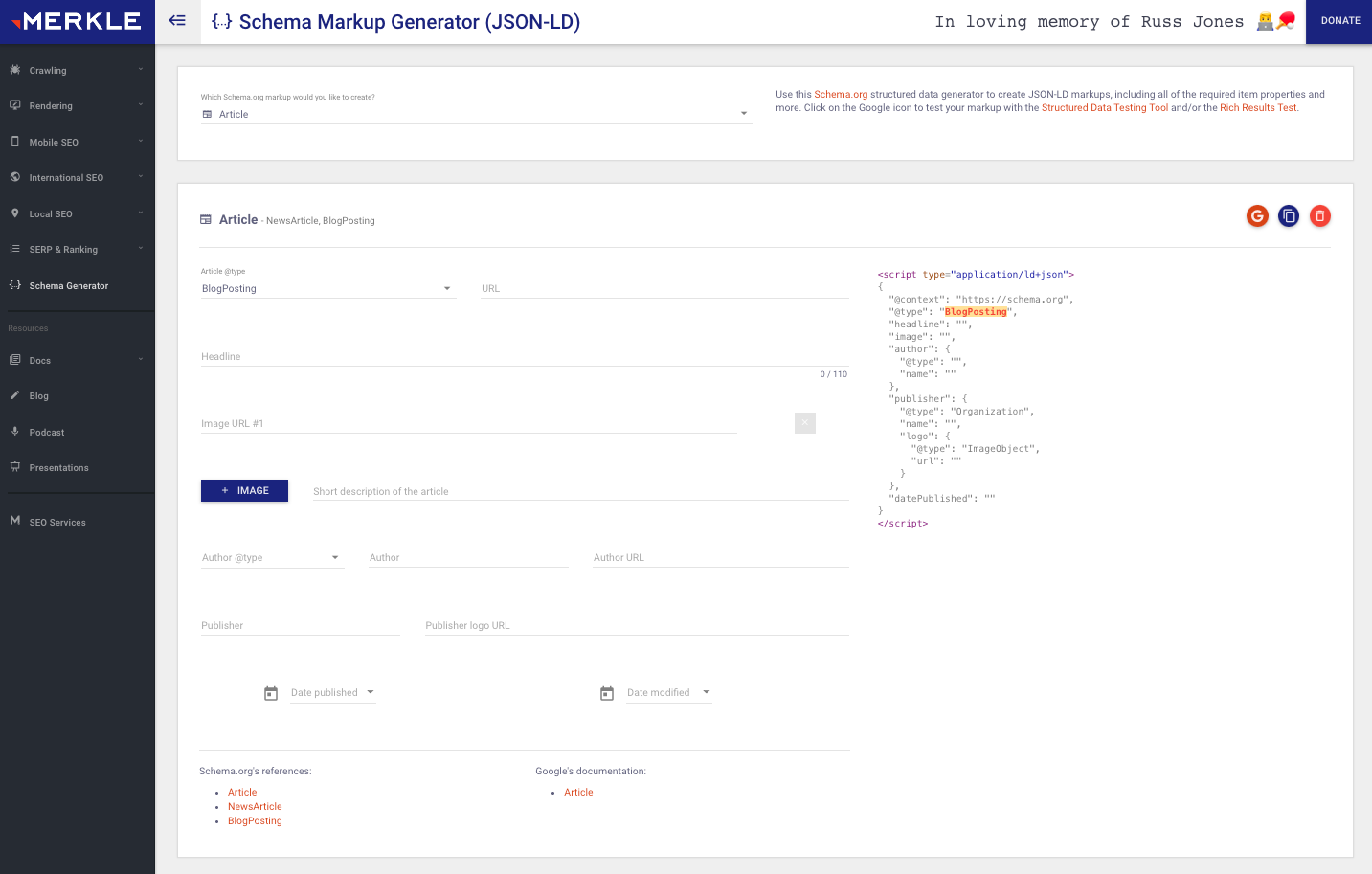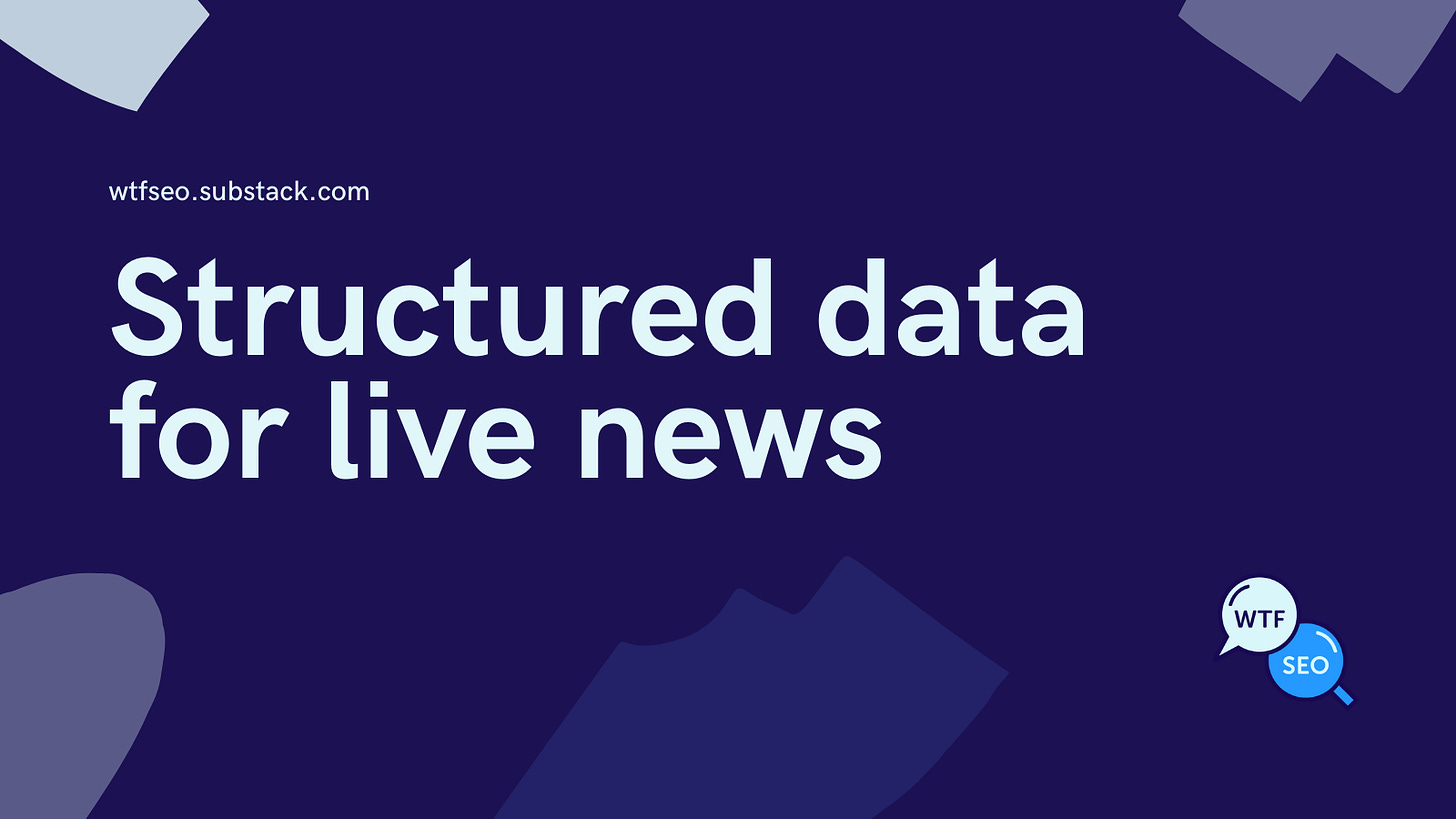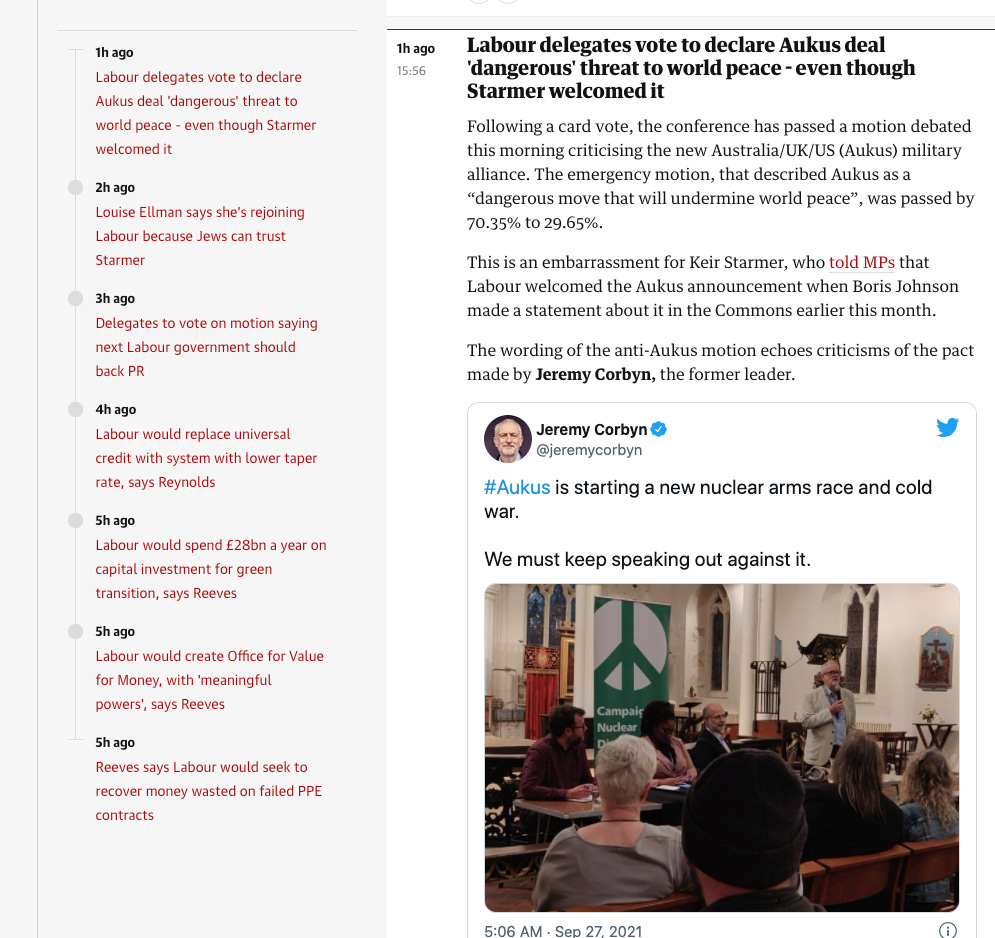Structured data for live news
In issue 32, Jessie looks at a type of structured data that is useful for live news environments and rolling news coverage (elections, debates). What's LiveBlogPosting Schema and how do we use it?
Hello and welcome back. This week, it’s me, Jessie, with a rare Tuesday edition of this newsletter. Apologies to anyone who repeatedly hit refresh on their email looking for us yesterday. Someone went to an apple orchard and got a little carried away (is 10 pounds of apples too much for one person? Who is to say!).
This week, we’re back talking about a particular type of structured data, inspired by this Twitter conversation: LiveBlogPosting Schema.

Let’s get into it.
In this issue:
What is structured data?
What is live blog posting?
How to add structured data to stories
THE 101
What is structured data?
As we went through in issue two of our breaking news series, structured data is a standardized way to provide search engines additional explicit clues about a page. The extra data helps search engines understand the meaning of the page or specific context within the page.
Schema.org – the official documentation and standardized format for structured data – is the result of a collaboration between Google, Bing, Yandex and Yahoo!. Bookmark Schema.org as the place to get official, clear guidance on all things structured data.
Remember that JSON-LD, the language that Schema is typically written in, is mutually exclusive from the HTML of your article page. The JSON-LD will not surface as content on your page, but will be readable by the search engines.
Why add structured data to our news pages?
There’s no clear result showing that structured data helps rankings – but we do know that search results with more rich snippets see better click-through rates. (Rich results are bonus SERP features such as People Also Ask or recipes that help bring targeted users to a website.)
What is LiveBlogPosting Schema?
We covered some of the basics, including reviews and recipes, in our previous issue. This week, we will focus on a type of schema that is useful for news SEOs: LiveBlogPosting.
A live blog is a subtype of the standard article structured data.
Schema’s official documentation says the purpose of the live blog is to “provide a rolling textual coverage of an ongoing event through continuous updates.”
In a live news context, publishers can use the LiveBlogPosting schema to try and surface their stories in Google’s Top Stories rich snippet feature.
This is important because there is a trend that Google is ranking articles that are updated with regular frequency. LiveBlogPosting structured data helps indicate to search engines that your page is updated with regular frequency and provides a service to readers, and therefore should be ranked as a live story (see the NYT example in Shelby’s election night tweet).
As a news organization, you should already have the NewsMediaOrganization markup and NewsArticle markup or Article markup on all news articles.
Use the SEO Pro Extension under the Schema tab to check; if it is not, work with your site or development teams to implement across article pages.
If you don’t have these on your pages already, you can set them up with help from your development team, through Yoast or by manually adding it to your article pages.
Many news outlets, including The Guardian (screenshot below), The New York Times and CNN, already have excellent (read: beautiful) live news templates that provide readers with clear, timely overviews of events as they develop. These are crafted with not only the user experience in mind, but also the structured data that makes it easier for crawlers and readers alike to get the information they need.
Every time the story is updated, the structured data is also updated to signal to search engines a change has been made.
How to add LiveBlogPosting to your live news events
Structured data is provided to search bots using JSON-LD (JavaScript Object Notation for Linked Data) – a language that is standardized and recognized by all search engines.
While this data can be written in microdata or RDFa, JSON-LD is the language Google prefers. It’s also less likely to break your site compared to other markups.

All JSON is structured to provide data in a property / value format. The property is the type of information you’re providing (for example, datePublished). The value is the information itself (for example, the value for the property datePublished would be 2021-09-27T16:27:52+0100).
Be as descriptive as possible when generating the structured data – fill in every possible field with detail. When populating the LiveBlogPosting, include (at minimum):
coverageEndTime: When your live blog will stop covering the news event (even if the event is ongoing – for example, German election results might take weeks to finalize – the end time is a signal to Google you’ve moved on).
coverageStartTime: When your live blog starts covering the news event. The start time can be before the news event itself (on election day, you would start your live coverage in the morning even if results are not expected until the evening).
Backstory: Includes a brief summary or explanation of the news event (what’s at stake, what’s expected to happen, etc).
Author: The Organization or Person helming the coverage.
liveBlogUpdate: This is the incremental update to the overall news event (on election day, an update to the LiveBlog would be the polls closing, initial results being reported, winners being declared, etc.). The expected type is BlogPosting.
How to populate live news Schema:
Bookmark the LiveBlogPosting documentation for reference and to understand what values are expected for each property;
Use a tool like Technical SEO or Yoast’s structured data component for WordPress users to generate the code; you can use the free text editor Atom to edit it further (if necessary);
Try Google’s Rich Results and Structured Data Validator to check for errors in your code;
Once the code is generated, it can be added in your CMS using an HTML block.
The process of this workflow will vary depending on the size and resourcing of your newsroom.
Try structured data in a non-breaking news, lower-stakes environment first (to keep from adding greys to your hair);
Once published, use the Schema tab of the SEO Pro Extension to triple-check the Schema is correct for errors once it is live on your site.

Best practices:
Make sure all article pages have Article schema;
Use the LiveBlogPosting schema for rolling news coverage;
Test and iterate your approach to land a featured spot in search results.
✔️ Action item: Use tools like Google’s Structured Data Markup Helper or Bing’s Guide to Marking Up Your Site to make sure your website is giving the search engine the information they need.
The bottom line: Structured data can be incorporated into your live news and rolling coverage. Strategize the best workflow for experimentation during news events to try to try to nab a featured placement in SERPs.
FUN + GAMES
SEO quiz
On Monday, Google celebrated its birthday. What year was Google founded?
1994
1996
1998
1999
RECOMMENDED READING
Claudio Cabrera, the deputy audience director, News SEO at The New York Times had a great, detailed thread about learning from losses as news SEOs.
Shared by Barry Adams on Twitter: What publishers need to know about the latest changes in Google search (titlepocalypse, Author schema, E-A-T)
Free SEO training: Structured data for beginners
Have something you’d like us to discuss? Send us a note on Twitter (Jessie or Shelby) or to our email: seoforjournalism@gmail.com.
(Don’t forget to bookmark our glossary.)
FUN + GAMES
The answer: Google in a Gen Z kid, founded on September 4, 1998 (though Google now celebrates its birthday on September 27, to coincide with the news of the record number of pages it was indexing.
Written by Jessie Willms and Shelby Blackley






Thank you for your informative information about Data Protection Laws Australia, as people are often concerned about their personal data. Data Protection Laws are a type of legislation that assists in the management of personal data and defines security regulations.
Is "live badge" limited to some languages and geo locations ?